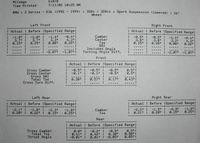July 2002
I managed to make my scheduled service appointment for installation of the front struts and dropped off the car. About two hours later I got a call from the service manager, during which he told me that someone had accidentally ordered struts for an E36 M3, rather than my E36 sport suspension. I thought I would be faced with having to reschedule the appointment but he told me that they had already opened an order to have the correct struts overnighted to them. As I had requested a BMW loaner (a 2002 325i), this was absolutely no inconvenience to me. I picked up the car the next day, as they had promised, with the struts installed and the car washed (this was actually a pleasant surprise since I hadn't any time to clean it for the past week).
As I now routinely do, I walked back to the bays and spoke with my mechanic. He showed me how the left strut had started to leak a bit (there were little gobs of oil covered with dirt around the top seal of the strut). The oil appeared to be about as dry as it could be (it didn't appear to be actively leaking), but its presence clearly showed it wasn't as healthy as the right strut, which was totally clean. My mechanic did point out that both struts were functional and could have run for some time, but he suggsted that this was the best move. Since I'm big on preventative maintenance, I couldn't agree more.
 He
also gave me a clue into the subtle (and not so subtle) differences between
the standard strut, the sport suspension strut, and the M3 strut. The most interesting
difference, aside from the length and valving, is the use of a ball bearing
sleeve on the top end cap on the sport model (which is a component of the strut
system, but not sold with the strut itself), while the standard uses a simple
plain bearing sleeve. The M3 struts are similar to their sport suspension cousins,
but are canted in their mounts to provide greater stability at speeds in excess
of 120 MPH.
He
also gave me a clue into the subtle (and not so subtle) differences between
the standard strut, the sport suspension strut, and the M3 strut. The most interesting
difference, aside from the length and valving, is the use of a ball bearing
sleeve on the top end cap on the sport model (which is a component of the strut
system, but not sold with the strut itself), while the standard uses a simple
plain bearing sleeve. The M3 struts are similar to their sport suspension cousins,
but are canted in their mounts to provide greater stability at speeds in excess
of 120 MPH.
Incidentally, if you're nuts, and actually considering the costly upgrade to bring a standard or sport E36 suspension up to M3 standards, remember...it's all or nothing. If you replace only certain components, it will be impossible to properly align the car, and you'll go through tires like a tornado through a trailer park. And, if you're wondering, it costs about $5K to do that...certainly not cost effective in my opinion. IMHO, if you can afford that kind of change, you'd be better off applying it to a nice used M3...at least in that case you'd get the more powerful M engine.
We then began to discuss the results from the state-of-the-art 4-wheel laser alignment system. If you've been a long-time reader, you may note that the mechanic wasn't blowing smoke when he reported some time ago that the rear tires had been wearing unevenly, and the results show why...the camber was at or near the limit. Now that the car has new tires, AND alignment, I should get the maximum effective wear from that set.
The good news of the day was that the sport suspension struts are about $125 each less expensive than the M3 struts, so I received a credit of $250, and a final bill (including labor and alignment) for only $215, bringing the total for this latest maintenance binge to $2215. If your jaw just dropped, consider that this maintenance has essentially returned the car to like-new status, at considerably less cost than a new car. I mean, the thing drives like the day it left the showroom...and I'm not exaggerating to justify the bills. I was particularly surprised how much nicer the car drives with the new struts -- and I didn't think the old struts were really affecting the handling....boy, was I ever wrong. This was one bill I was almost glad to pay.
The only thing left to do in maybe 20K miles is the rear shock mounts (another known issue in the E36), as they are purposefully made soft to improve the ride characteristics as well as protect the suspension components. My mechanic recommended we do the shocks in there while we're at it, and that's likely what I'll do.



